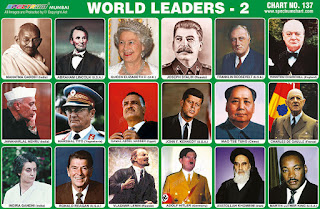 |
| World Leaders 2 Chart |
Spectrum Chart - 137 : World Leaders 2
- Mahatma Gandhi (India) - Mohandas Karamchand Gandhi was the pre-eminent leader of the Indian independence movement in British-ruled India. Gandhi led India to independence and inspired movements for civil rights and freedom across the world. His birthday, 2 October, is commemorated world-wide as the International Day of Nonviolence.
- Abraham Lincoln (U.S.A.) - Abraham Lincoln was the 16th President of the U.S.A. He served as president from 1861 to 1865, during the American Civil War. Lincoln has been remembered as the "Great Emancipator" because he worked to end slavery in the U.S.A.
- Queen Elizabeth II (U.K.) - Elizabeth II is and has been since her accession in 1952, Queen of the U.K., Canada, Australia and New Zealand and Head of the Commonwealth. The countries of which she is Queen are known as Commonwealth realms. Since 9 September 2015, Elizabeth II has ruled longer than any other king or queen in the history of the U.K.
- Joseph Stalin (Russia) - Joseph Stalin was the leader of the Soviet Union from 1922 until his death in 1953. His ideas and policies turned the Soviet Union into a powerful, modern nation, the largest on Earth. It also led to the deaths of millions of people. His form of government was later called Stalinism.
- Franklin Roosevelt (U.S.A.) - Franklin D. Roosevelt was the 32nd President of the United States from 1933 until his death in 1945. He served as United States President longer than any other President. For overcoming the difficult challenges of a depression and a world war, historians generally consider him to be one of the best U.S. presidents.
- Winston Churchill (England) - Sir Winston Churchill was an English politician. He was Prime Minister of the United Kingdom twice. He was also a soldier, journalist and author. He won the Nobel Prize in literature in 1953 and was the first person to be made an honorary citizen of the United States.
- Jawaharlal Nehru (India) - Jawaharlal Nehru was the first Prime Minister of India and a central figure in Indian politics before and after independence. He remained prime minister for 17 years until his death in 1964. In India, his birthday on 14th November is celebrated as Children's Day.
- Marshal Tito (Yugoslavia) - Josip Broz, nicknamed Tito, was the leader of the Socialist Federal Republic of Yugoslavia, from 1945 until his death in 1980. Tito was seen by most as a benevolent dictator due to his economic and diplomatic policies. He was a popular public figure both in Yugoslavia and abroad.
- Gamel Abdel Nasser (Eygpt) - Gamal Abdel Nasser Hussein was the second President of Egypt, serving from 1956 until his death. Nasser is seen as one of the most important political figures in modern Arab history and politics. Under his leadership, Egypt nationalized the Suez Canal and a lot of other industries.
- John F. Kennedy (U.S.A.) - John Fitzgerald Kennedy was the 35th President of the United States. He was in office from 1961 until his assassination in 1963. He was the youngest President elected to the office, at the age of 43.
- Mao Tse Yung (China) - Mao Zedong also transliterated as Mao Tse-tung and commonly referred to as Chairman Mao was a Chinese Communist leader. He was the leader of the People’s Republic of China (PRC) from its establishment in 1949 until his death in 1976.
- Charles De Gaulle (France) - Charles de Gaulle was a French military and political leader. He was president of France from 1959 to 1969, and was a founding member and leader of the French Resistance during the Second World War. He was the dominant figure of France during the cold war era.
- Indira Gandhi (India) - Indira Gandhi to date is the only female Prime Minister of India. She served as Prime Minister from 1966 to 1977 and then from 1980 until her assassination in 1984. As Prime Minister of India, Indira Gandhi was known for her political ruthlessness and unprecedented centralisation of power.
- Ronald Reagan (U.S.A.) - Ronald Reagan was an American actor and politician. He was the President of the United States from 1981 to 1989. Reagan was a movie, television and radio actor before he began his career in politics. Reagan remains one of the most popular presidents in American history because of his optimism for the country.
- Vladimir Lenin (Russia) - Vladimir Lenin was a Russian lawyer, revolutionary and the leader of the Bolshevik party and of the October Revolution. He was the first leader of the USSR and the government that took over Russia in 1917. Lenin's ideas became known as Leninism.
- Adolf Hitler (Germany) - Adolf Hitler was a German politician who was the leader of the Nazi Party & Chancellor of Germany from 1933 to 1945. As dictator of Nazi Germany, he initiated World War II in Europe with the invasion of Poland in September 1939.
- Ayatollah Khomeini (Iran) - Ayatollah Khomeini was an Iranian Shia Muslim religious leader, revolutionary, politician, the founder of the Islamic Republic of Iran and the leader of the 1979 Iranian Revolution which saw the overthrow of the Pahlavi monarchy and Mohammad Reza Pahlavi, the Shah of Iran.
- Martin Luther King (U.S.A.) - Martin Luther King was an American pastor, activist, humanitarian and leader in the African-American Civil Rights Movement. He is best known for improving civil rights by using nonviolent civil disobedience, based on his Christian beliefs.

No comments:
Post a Comment